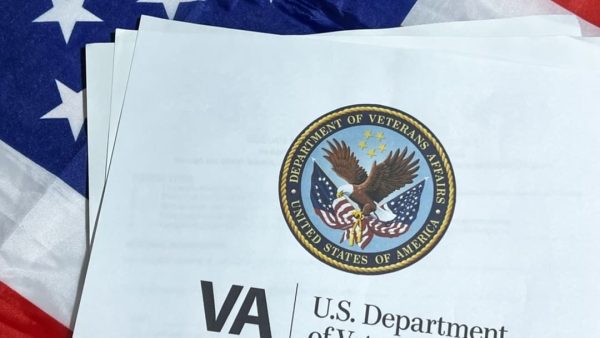Looking for Expert-Level VA Claim Answers?📱Call Us Now! 737-295-2226
If you have a service-connected disability, receiving the correct VA rating is vital for ensuring you get the VA disability compensation and benefits you rightfully deserve.
However, if your condition worsens over time, you may be eligible for a VA disability rating increase—and potentially VA disability back pay.
This back pay can provide significant retroactive benefits for the time you waited to receive the increased VA rating.
Let’s dive in and find out how much you’re owed.
Table of Contents

Summary of Key Points
- Veterans may receive VA back pay for a disability increase if their condition worsens and they file for an increase within one year of the change, or from the date they submitted the request.
- Once the VA approves a disability rating increase, back pay is typically issued in a single payment or lump sum.
- The effective date for VA back pay will depend on what type of claim you have (i.e., Direct Service Connection).
What is VA Back Pay?
VA back pay is a retroactive payment you may receive if your VA benefits rating increases.
If the VA determines that a veteran’s service-connected condition has worsened, they may assign a higher VA disability rating to reflect the increased severity.
Back pay is then calculated from the effective date of the increase, which is typically the date when the disability worsened or the date you filed the disability claim for an increase, whichever is earlier.
For example, if your symptoms worsened in March 2022, and you filed for an increase in February 2023, your effective date would be March 2022, since the claim was filed within one year of the worsening. If the claim were filed after March 2023, the effective date would be February 2023.
Once the VA approves a disability rating increase, back pay is typically issued in a single payment or lump sum.
You may also like: How does back pay work for VA disability?
Do I Get Back Pay for VA Disability Increase?
Yes, if your symptoms worsen and you’re awarded a higher VA disability rating, the VA may issue back pay for the difference between your previous and updated ratings.
For example, suppose you submitted evidence of worsening on June 1st but only received the increased VA disability rating decision on December 1st. In that case, you’d be eligible for retroactive benefits for those intervening months.
Effective Date for VA Disability Back Pay
For VA disability claims, the effective date is crucial because it determines how far back the VA will calculate retroactive payments. The effective date is the day you can start getting your disability benefits.
The type of claim will determine the effective date.
Direct Service Connection
The effective date for a disability that was caused—or made worse—by military service is whichever of these comes later:
- The date the VA gets your claim, or
- The date you first got your illness or injury (also known as the date your entitlement arose)
If you file your claim within a year of leaving active service, the effective date can be the day after separation.
Secondary Service Connection
The effective date for a secondary service connection claim is generally the date the VA received your claim for the secondary condition, or the date entitlement arose, whichever is later.
Presumptive Service Connection
Generally, if the VA believes your presumptive disability is related to your military service and they get your claim within one year of your separation from active service, the effective date is the date you first got your illness or injury.
However, if the VA receives your claim more than 1 year after your separation from active service, the effective date is the date they got your claim or when you first got your illness or injury (whichever is later).
Reopened Claims
The effective date for a reopened claim is the date the VA receives the claim to reopen, or the date you first got your illness or injury (whichever is later).
Read More: VA Effective Date
Staged Ratings and VA Back Pay
In some cases, the VA may assign a staged rating if your symptoms change over time.
This means the VA provides different ratings for different time periods, allowing them to compensate you accurately for each period.
For example, if your symptoms worsened for six months before stabilizing, the VA might assign a higher rating for those six months than a lower one for the following time.

Who Qualifies for VA Disability Back Pay?
VA disability back pay is available to veterans who have a delay between their claim’s effective date and the date they receive an approval decision for VA disability benefits.
You may be eligible for back pay if:
- Your initial VA disability claim was approved.
- You requested a higher disability rating due to worsening symptoms, and it was granted.
- You appealed a denied claim, and the VA awarded benefits with back pay.
- A previous VA decision was corrected due to a clear and unmistakable error.
VA Back Pay Timeline
The VA calculates back pay based on the difference in monthly compensation between the previous rating and the new one.
This payment is typically one lump sum and can be significant if the effective date is many months (or years) before the final decision.
In some cases, veterans may receive an effective date earlier than the date they filed. For example, if medical evidence showed that your condition worsened before your filing date, the VA might use that earlier date as the start of your increased rating.
Related: Read more about how long it takes to get back pay HERE.
Filing a Supplemental Claim for a Higher VA Disability Rating
If you disagree with your current disability rating or believe your condition warrants a higher rating, you can file a supplemental claim.
A supplemental claim allows you to submit new or additional evidence supporting a higher disability rating, which could lead to increased benefits and VA disability back pay.
For example, if a disabled veteran experiences worsening symptoms of PTSD or another service-connected condition, they can file a supplemental claim with updated medical documentation.
If the VA approves the claim, they will calculate back pay based on the effective date, potentially providing retroactive pay for the difference between the old and new ratings.
When Do You Receive VA Back Pay?
Once your VA disability claim is approved, it typically takes a few weeks to receive back pay, which is issued as a lump sum, unlike standard disability payments that are issued monthly.
If you believe your effective date should be earlier or your rating should be higher, filing a supplemental claim or seeking a higher-level review can change your back pay monthly payments.
5 Expert Tips for Seeking VA Disability Back Pay
Here are a few tips if you’re hoping to maximize your VA disability back pay:
- File Promptly: When symptoms worsen, filing as soon as possible allows the VA to assign an effective date closer to the time of the worsening.
- Provide Medical Evidence: Submit all relevant medical records showing the progression of symptoms. Veterans with well-documented cases typically see better outcomes with their back pay calculations.
- Consider a Higher-Level Review if Needed: If you believe the VA has made an error with your effective date or back pay amount, requesting a higher-level review may resolve the issue and provide a fair back pay calculation.
- Understand the VA Disability Rating Criteria: Reviewing the VA’s disability rating criteria can help you understand how your symptoms align with higher ratings and whether you may qualify for an increase.
- Request a Staged Rating When Applicable: For veterans whose symptoms change over time, requesting a staged rating may result in more accurate and higher back pay amounts.
If you have fluctuating symptoms, document these changes carefully and include any relevant medical evidence with your VA claim.

(FAQs) Frequently Asked Questions
How do I know if my disability increase qualifies for VA back pay?
If your disability rating is increased based on a worsening condition, and you can prove when the symptoms intensified, you may be eligible for back pay.
Will I need a C&P exam when I claim a VA disability increase?
Yes, most likely. The VA typically requires a C&P exam to confirm the current severity of your condition and determine if an increase is warranted. The C&P exam results can influence both the new rating and the effective date.
How long does it take to receive VA back pay?
Once your increase is approved, the VA usually issues back pay within a few weeks to a few months. Processing times vary based on the complexity of your case and the VA’s current workload.
-
Pro Tip: You can always call 800-827-1000 to see the status of your back pay.
Can back pay be awarded for conditions that worsen over time?
Yes, the VA can award back pay for progressive conditions if you can show medical evidence documenting the increase in severity.
How does the VA determine the effective date for back pay?
The VA will typically use the date when your symptoms worsened as the effective date if you file within a year of that change. Otherwise, the effective date may revert to your claim’s submission date.
Can you receive VA back pay for multiple claims?
Yes, you can receive back pay for multiple claims. For instance, if you applied for both PTSD and a knee injury, and the VA grants ratings for both, you’d receive back pay for each condition based on the effective dates.

Want Expert-Level VA Disability Claim Help? WE GOT YOUR SIX!
- VA Claims Insider is the #1 most trusted name in VA disability claims.
- Work directly with a VA claims coach who can guide you to VA claim victory.
- 25,000+ disabled veterans served in our membership programs since 2016.
- 30% average rating increase for veterans who complete our #1 rated Elite program.
- 4.7/5.0 average rating out of 5,500+ total reviews; over 4,500 5-star reviews.

Kelly Olone
Kelly Olone is a military spouse who earned her degree in Psychology from Florida International University. After working in the non-profit sector for several years, she turned to her passion for writing. She aims to contribute to a better understanding of the valuable benefits that veterans deserve. As a mom, Kelly navigates the delicate balance between deadlines and bedtime stories with finesse.



